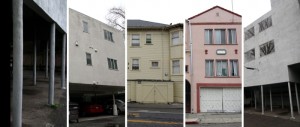19 Oct Earth Shattering New LA Quake Retrofit Law!
Earth Shattering New LA Quake Retrofit Law!In a unanimous decision, the Los Angeles City Council voted to approve a bill mandating that thousands of older apartment buildings around the city get retrofitted by hold up during an earthquake. Mayor Eric Garcetti signed the bill on the spot, noting that the new law will make the city safer and better able to withstand a major earthquake.
“Today’s actions will save lives,” Garcetti told the Los Angeles Times prior to the signing. “I’m not interested in making history or having the toughest laws. I’m interested in preserving our city’s ability to survive and thrive after an earthquake.”
The new rules are being called the toughest in the nation by the Los Angeles Times and others, and there is a good reason for creating such a tough law right now. The Associated Press points out that, thanks to Los Angeles’s proximity to the famed San Andreas Fault, seismologists have been warning that a major earthquake (around 7.8 in magnitude on the Richter Scale) will inevitably hit the city at some point. The only thing in doubt is when that will happen and how well the city will be able to withstand it.
Unfortunately, the city is not prepared for such a significant seismic event right now. Earlier studies have estimated that such a quake could kill as many as 18,000 people in Los Angeles while also causing up to $250 billion in damage. And while a huge earthquake is obviously going to cause plenty of damage no matter what the city does to prepare, the new law should go a long way toward reducing both of those disturbing figures.
Of course, the risk posed by the San Andreas Fault has been common knowledge among Los Angeles residents for decades. The city has mostly avoided the issue for an equally long period of time though, for a variety of reasons. However, it would seem that everyone–including the building owners themselves–finally agree that it is time to act.
“We want the buildings to be safe,” Martha Cox-Nitikman, a representative of the Building Owners and Managers Association of Greater Los Angeles, told the Los Angeles Times. “But we need to figure out how we get people there without ruining businesses.”
Unfortunately, the cost of the project does remain a valid concern. The new law could effect up to 15,000 buildings across the city and, for now, it looks like the bulk of the cost may have to be shouldered by the owners of those buildings.
The vast majority of the buildings (about 13,500) are apartment buildings with soft first stories. Many of those buildings are constructed with wooden frames and sit perched over first-floor parking garages. For those buildings, the cost of the construction could range anywhere from $60,000 to $130,000 per building on average, according to the AP. The remaining 1,500 buildings in need of an earthquake retrofit are mostly made from brittle concrete, and the construction costs could rise into the millions for the taller buildings among that group.
Right now, the law gives landlords the option of raising rent payments as much as $75 a month to help cover the cost of the retrofit, according to the AP. However, both owners and tenants seem to agree that a price bump that large simply isn’t realistic, as most tenants would not be able to afford the additional cost. Instead, landlords are looking to the city and perhaps the state government to help reduce their overall expense through various tax breaks and waived fees.
California Governor Jerry Brown was considering a bill proposed by Assemblyman Adrian Nazarian that would have given building owners a tax break covering 30% of their retrofit costs. However, Brown decided to veto the bill, citing the need to keep the state’s budget balanced. With the continuing concern over the budget in California, building owners and tenants may have to look elsewhere for assistance with covering the cost of the retrofit.
If the city of Los Angeles does not find a way to offset some of the cost for building owners, then rent prices may ultimately go up in some places. One plan still under consideration would have landlords and their tenants share the cost about equally, through a $38 per month surcharge–or about half of the $75 maximum rent increase–added to the normal rent to help pay for the construction, according to the AP.
But while the cost associated with the retrofit construction are likely to be problematic for many people, it’s clear that making the comparatively small sacrifice now could save a lot of lives in the future. Lucy Jones, a seismologist with the U.S. Geological Survey and the earthquake science adviser to Mayor Garcetti, pushed the city council to pass the plan for that reason. Jones also points out that retrofitting old concrete buildings is particularly vital.
“They are the deadliest buildings when they fall,” Jones told the Los Angeles Times. “Because concrete is heavy, they kill people.”
The way concrete reacts under stress also makes those buildings particularly dangerous. Without sufficient support from steel beams or strong interior walls, concrete can fracture around support columns, creating not only the danger of concrete falling on people in the building, but also the total collapse of the building itself.
Los Angeles’s most recent push to finally put an earthquake retrofit plan into action for its older buildings may owe something to a major earthquake that struck New Zealand in 2011. The Los Angeles Times recalls that the city of Christchurch two concrete towers collapsed during the quake, which resulted in 133 deaths, and reminded Los Angeles (and the rest of the world) just how dangerous old concrete buildings become during a major seismic event.
As a result of the quake in New Zealand, the Los Angeles Times decided to figure out how many similar brittle-concrete buildings there were within the city of Los Angeles. In the aftermath of the catastrophe in Christchurch, their finding was nothing short of alarming. The Los Angeles Times was able to locate more than 1,000 such buildings within the city, and found that only a tiny fraction of them were already retrofitted to withstand a major earthquake.
It wasn’t long after that that Mayor Garcetti kicked off his effort to address the city’s need to get started on a serious earthquake retrofit plan. He appointed Jones as his earthquake science adviser, and she went to work raising awareness about the looming danger to the city.
“You don’t get to pretend this isn’t going to happen,” Jones said. “The earthquake is inevitable.”
This past December, Mayor Garcetti released a plan to identify and then retrofit not just at-risk apartments and other buildings, but also vulnerable infrastructure like water systems, according to the AP. Maintaining the integrity of the city’s telecommunication systems during and after a major quake is another priority. Ultimately, the goal is to minimize damage to the city from the inevitable seismic event, save as many lives as possible, and prevent a major economic collapse in the quake’s aftermath.
This new law is an essential step in Garcetti’s push to make the city safer from earthquakes. And although there is still plenty of work to be done before Los Angeles can truly claim to be prepared for the coming earthquake, it is clear that the city is finally moving in the right direction.



